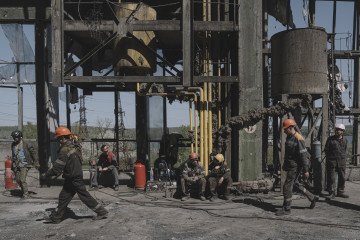- Category
- Life in Ukraine
How the Disappearance of Eagles in Ukraine Is Connected to Russia's War

Amidst the ongoing war in Ukraine, the endangered Great Spotted Eagle faces heightened risks as Russia’s military activities disrupt their natural habitats. The destruction of the Nova Kakhovka dam and the resulting ecological damage further threaten these majestic birds, underscoring the broader environmental damage caused by the war.
Russia’s war in Ukraine, particularly since the full-scale invasion in 2022, is undoubtedly affecting human lives. But it is also wreaking havoc on the natural world. The total climate damage that Russia caused in the first 555 days of the full-scale invasion amounts to almost USD 10 billion. We look at how the war in Ukraine is driving eagles away from their habitats and the broader ecological impacts of the conflict.
The Disappearance of Eagles
Today, eagles—particularly the Great Spotted Eagle—are endangered and are among the most affected species in Ukraine. These birds of prey rely on large, undisturbed territories for hunting and breeding. However, the intensification of military activities has disrupted their habitats, leading to a noticeable decline in their populations.
The constant noise from artillery, airstrikes, and military vehicles is a significant stressor for eagles. These birds have acute hearing and rely on quiet environments to hunt and communicate. The cacophony of war disturbs their natural behavior, making it difficult for them to find food and mates. Many eagles have been observed abandoning their nests, leading to a decrease in successful breeding.
The war has also led to restricted airspace, not only for human aviation but for avian species as well. Drones, helicopters, and fighter jets dominate the skies, creating a hazardous environment for birds. Eagles and other raptors are instinctively avoiding these areas, altering their migratory patterns and pushing them into unfamiliar and often less suitable territories. This forced migration disrupts their ecological roles and increases mortality rates due to collisions, exhaustion, and starvation. Despite all the tagged birds surviving, researchers believe their experience may have affected their ability to breed. The destruction of the Nova Kakhovka dam also led to widespread water pollution. The flooding washed away industrial sites, agricultural fields, and urban areas, releasing toxic substances into the river system. These pollutants have severely degraded water quality, affecting fish populations that eagles rely on for food. The decline in prey availability has forced eagles to abandon their traditional hunting grounds, exacerbating their struggle for survival.
The eagles disappearing from Ukraine’s airspace has made headlines recently. However, they are just a symptom of a bigger ecological catastrophe that Russia has brought upon Ukraine and Europe as a whole.
The impact of the Nova Kakhovka Dam destruction
In June 2023, Russian forces destroyed the Nova Kakhovka dam, resulting in catastrophic flooding along the Dnipro River. This event had immediate and severe ecological consequences, impacting both aquatic and terrestrial ecosystems. To put it into numbers, nearly 90% of the reservoir was drained, exposing 1870 square kilometers of the former lakebed. The reservoir also served as a crucial water source for numerous major cities located to the north, west, and south of Ukraine. The dam breach has led to the discharge of around 150 tons of oil products from the hydroelectric power plant, potentially spreading downstream and reaching the Black Sea. The contamination of water there poses long-term health risks to both animals and humans. Furthermore, an estimated 80,000 hectares of protected areas, such as the Lower Dnipro Natural Reserve and Askania-Nova, are at risk of destruction. To put Askania-Nova’s importance into perspective, across 33.3 thousand hectares, 3,000 species of rare animals – zebras, wildebeest, bison, buffalo, deer, and wild horses – lived there in partial freedom. It is also known that the Russian forces have illegally transported Red-listed animals to Russia from the Askania Nova biosphere reserve. Their physical state is unknown.
The flooding caused by the dam's destruction submerged vast areas of wetlands, forests, and farmlands, which serve as crucial habitats for numerous species, including eagles. These habitats are essential for breeding, hunting, and shelter. The sudden inundation forced wildlife to flee, often into areas where they could not survive. Downstream in the lower Dnipro Basin, the rush of contaminated floodwaters from the breach severely impacted rare habitats, including the 80-square-kilometre Oleshky Sands National Nature Park, located east of Kherson. As the second-largest sand area in Europe, it serves as a habitat for the endangered sandy blind mole rat. This would put many of these endangered species at risk of drowning. Overall, 24 protected areas have been forced to suspend their conservation activities due to the war: in Donetsk, Luhansk, Zаporizia, Kherson, Mykolaiv, Kharkiv, Sumy, Chernihiv, Kyiv, and Crimea regions.
The emptying of the reservoir left 28,000 crucian carp washed out or stranded. There is no doubt that this will impact the whole animal food chain.
Many valuable representatives of the flora were also lost. These are all rare flowers, in particular, populations of wild orchids. Parts of the birch and oak forests, including some of the largest giant oaks of the Kherson region, that are located in the Zburyiv Forestry, near the banks of the Dnipro, were also destroyed.
Landmines: A lethal threat to wildlife
Ukraine is the most contaminated by landmines country in the world. These mines are designed to maim or kill anyone who triggers them, but their impact extends far beyond immediate human casualties. They create uninhabitable landscapes, impede agricultural activities, and pose a continual threat to wildlife. The mines and artillery shells the Russians fired into the north of Ukraine set off fires that have burnt through more than 2,000 hectares of previously untouched forest. The destruction of forests due to landmines also impacts global efforts to combat climate change. These natural landscapes act as carbon sinks, absorbing carbon dioxide from the atmosphere. When they are destroyed, their capacity to sequester carbon is diminished, exacerbating the effects of climate change.
After a woodland area burns down, a sombre consequence follows: the wildlife will not come back there for a while. The north of Ukraine is home to a region known as Polissya, which is rich with woodlands and is home to species like lynx, wolf and moose – some of which disappeared from most of the rest of Europe a long time ago. The animals cannot see the mines, and deer in particular often fall victims to a triggered landmine.
Moreover, the presence of landmines restricts conservation efforts and habitat restoration. Biologists and conservationists cannot safely access many areas to monitor animal populations or implement protective measures. This inability to intervene massively hampers efforts to mitigate the war's ecological impact.
Even after the war ends, the legacy of landmines will continue to haunt Ukraine. The process of clearing mines is slow, dangerous, and expensive. Unexploded mines can remain active for decades, posing a long-term threat to the environment and human safety. The persistent contamination will hinder efforts to rebuild and restore the affected areas. Landmines near rivers, lakes, and other water bodies pose a severe risk of water pollution. When mines explode, they release toxic substances into the water, affecting aquatic life and making the water unsafe for human consumption. Additionally, unexploded mines can corrode over time, leaching hazardous chemicals into the water and causing long-term ecological damage.
Wider impact of Russia’s war
As deforestation has been covered extensively in this article, it is also important to note that it has severely impacted the country's renewable energy infrastructure. Since the onset of the full-scale war, 90% of Ukraine's wind power and 50% of its solar energy capacity have been rendered inoperative. This significantly stumbles Ukraine's progress in renewable energy over the years.
Putin has inadvertently made a compelling case for reducing dependence on fossil fuels, especially those sourced from unstable autocratic regimes that use energy as a means of coercion. For instance, in the EU, gas consumption decreased by nearly 20% in 2022 due to fuel-switching and demand-side initiatives.
To put things into perspective, everything about war affects the environment: destruction of oil fuel facilities pollutes the air; movement of military equipment generates fossil-fuel emissions; bombs increase the concentration of fine particulate matter. Russia also uses almost every artillery known to man: hypersonic missiles, fighter jets, kamikaze drones, and chemical weapons. The latter is particularly dangerous: riot control agents and white phosphorus bombs create a lasting effect. Phosphorus can build up in fish that live in contaminated streams. White phosphorus may also stick to particles in the soil, and it takes days for them to break down to less harmful compounds.
Russia’s war in Ukraine has not only caused immense human suffering but has also inflicted severe environmental damage. The international community must support efforts to mitigate these impacts, including mine clearance, ecological restoration, and the transition to renewable energy. Only through concerted efforts can we hope to heal the environment and safeguard it for future generations.
-b478bbe76fb80662b124ed8605d6b221.jpeg)

-29a1a43aba23f9bb779a1ac8b98d2121.jpeg)

-f88628fa403b11af0b72ec7b062ce954.jpeg)

-24deccd511006ba79cfc4d798c6c2ef5.jpeg)

-73e9c0fd8873a094288a7552f3ac2ab4.jpg)